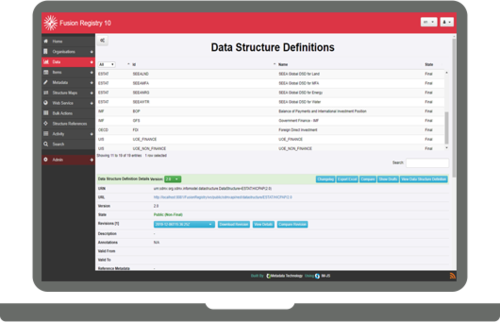Main Page
The Fusion Registry Knowledge Base
Statistical data management software for official statistics using SDMX
Fusion Registry 10
Fusion Registry 10 is for central banks, international organisations, national statistics offices, development banks and regional statistics authorities who need to collect, integrate, store, process and publish aggregated official statistics using the SDMX Standard.
Fusion Registry is a metadata-driven system providing closely governed, reliable and automated management of the statistical data supply chain, production process and dissemination service.
Version 10.0 was released in January 2020 and comes in three editions:
- Data Essentials - a free to use version with data handling capabilities suitable for personal use or simple use cases.
- Enterprise - a paid-for fully-featured SDMX data and metadata solution suitable for production deployment and sophisticated use cases.
- Cloud - the Enterprise Edition delivered as a fully-managed cloud service.
Fusion Registry Components and Modules
Fusion Registry 10 consists of a suite of components and modules centred on the Fusion Registry core.
Fusion Registry Core
SDMX statistical data engine and structural metadata registry.
The main statistical engine for data collection, integration, processing, storage, query execution and time-series calculations. It provides an SDMX-compliant data and metadata REST API.
The integrated SDMX structural metadata registry acts as the central repository, authoring and maintenance tool for all of the structures including Codelists, Concepts and Data Structure Definitions.
More
Fusion Edge Server
High-performance data dissemination server.
A light-weight SDMX data and metadata REST API server designed to be deployed in clusters in the DMZ or at the network edge for scalable, fault-tolerant public data dissemination use cases.
More
Fusion Data Browser
Interactive data explorer and analysis web tool for analysts and statisticians.
Fusion Data Browser is a web application suitable for both internal and external data consumers to search and explore the catalogue of datasets, select series and cubes of interest, build visualisations using tables and charts, and retrieve selected data in a variety of formats including SDMX, Excel and CSV.
It can connect to either a Fusion Registry Core engine, or a Fusion Edge Server cluster.
More
FusionXL
Microsoft Excel addin for Fusion Registry.
FusionXL is an Excel addin for browsing and modifying structural metadata, exploring the data catalogue, and downloading data directly into a spreadsheet.
Fusion Data Mapper
Web tool for creating and maintaining Fusion Registry FAME to SDMX series mappings.
Web tool for Fusion Registry Core for mapping series with a single dimension to richer multi-dimensional structures using SDMX structure mapping rules.
The main use case is mapping FAME series which typically have a single 'series code' dimension to SDMX multi-dimensional structures including dimensions and attributes like: FREQ, INDICATOR, REF_AREA and UNIT_MULT. However, it will work with source data with a single dimension like 'Indicator'.
Fusion ETL Server
Module for Extracting, Transforming and Loading data into Fusion Registry.
Fusion ETL extracts observation data from one or more local SQL databases and loads them into a Fusion Registry Core data engine, transforming the data into the structure specified for the target SDMX Dataflows.
Any number of jobs can be created that can be executed interactively through the web user interface, executed automatically on a defined schedule, or triggered programmatically using the Fusion ETL REST API.
Fusion Registry Command Line
Windows and Linux command line interface.
A command line interface to Fusion Registry's REST API providing utility scripts for loading structures, data and metadata, validating data, exporting content and deleting content.
Fusion Registry Core Topics
| Structural Metadata | Detailed explanations of the main SDMX structural metadata artefacts |
| How To | Guidance on specific tasks using Fusion Registry |
| Behaviours | Answers to 'What happens when...?' questions |
| Components and Modules | Components and modules reference |
| Functions Reference | Features and functions reference |
| Data Formats | A description of supported Data Formats |
| Security | Authentication and Authorisation Features |
| Web Services | Registry Web Services |
| Command Line | Structure, data, and metadata publishing from the command line |
| Glossary of Terms | Glossary of SDMX and Fusion Registry terminology |
Fusion Data Mapper
Fusion Data Mapper provides a web user Interface to administer Structure Maps in the Fusion Registry, where the maps support a specific use case – mapping from Single Dimension Data Structures to multidimensional Data Structures. This use case is borne out of statistical applications which model time series datasets as a single unique identifier for the Series alongside a Time Dimension. By modelling these dataset as a DSD with one Dimension (and a Time Dimension), it is very easy to overlay SDMX metadata to describe the Time Series as a multidimensional Cube with additional series Attributes to carry richer metadata.
| Installation | How to Install Fusion Data Mapper |
| Add Dataset | Creating new Mapped Dataflows |
| Maintaining Rules | How to create and maintain mapping rules |
| Query Forwarding | How data queries are forwarded from the Target to Source Dataflow using mappings |
| Videos | Data Mapper in Action |
Fusion Metadata Registry Topics
What is Fusion Metadata Registry?
| How to Guides | Guidance on specific tasks using Fusion Metadata Registry |
| Configuration Reference | Guidance on how to configure Fusion Metadata Registry |
| Concepts Reference | Explanation of useful basic SDMX structural metadata concepts |
| Structures Reference | Guidance of each of the structure types available in Fusion Metadata Registry |
| Formats Reference | Guidance of each of the format types available in Fusion Metadata Registry |
| REST API Reference | Purpose, parameters, request content and response content for each of the published web services together with examples |
